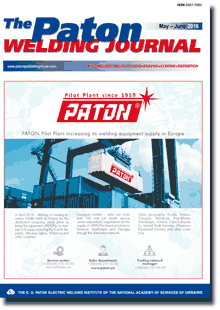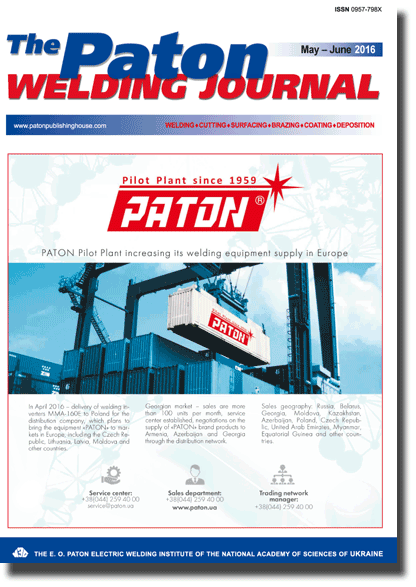| 2016 №06 (24) |
DOI of Article 10.15407/tpwj2016.06.25 |
2016 №06 (26) |

The Paton Welding Journal, 2016, #5-6, 143-149 pages
Dependencies of discrete-additive formation of microvolumes of metal being solidified in multi-layer microplasma powder surfacing of nickel alloys
K.A. Yushchenko, A.V. Yarovitsyn And N.O. Chervyakov
E.O. Paton Electric Welding Institute, NASU 11 Kazimir Malevich Str., 03680, Kiev, Ukraine. E-mail: office@paton.kiev.ua
Abstract
Peculiarities of heat input, bead cross-section area and efficiency were investigated at single-layer microplasma powder surfacing of nickel heat-resistant alloy JS32 on narrow substrate of 1–2 mm thickness. It is determined that series of its modes using 5–15 A welding current differs by the minimum heat input. Calculated evaluation of stress-strain state of a welded joint was carried out for its minimum and maximum level during building-up of edge of a plate using single- and three-layer surfacing. It is shown that the value of heat input in microplasma surfacing determines a width of plastic deformation zone and value of sum plastic deformations as a result of reheating in multi-layer surfacing. New technological principles were proposed for selecting the modes of multi-layer and 3D-microplasma powder surfacing of the parts from nickel heat-resistant alloys, providing the minimum heat input in a part and regulating requirements to welding current value, time of existence of metal of weld micropool in molten state and its volume. 20 Ref., 2 Tables, 10 Figures.
Keywords: microplasma powder surfacing, narrow substrate, nickel heat-resistant alloy JS32, effective power of part heating, heat input, bead cross-section area, volume of weld micropool, surfacing efficiency, stress-strain state of welded joint
Received: 28.02.16
Published: 19.07.16
References
- Frolov, V.V., Vinokurov, V.A., Volchenko, V.N. et al. (1970) Theoretical principles of welding. Moscow: Vysshaya Shkola.
- Karasev, M.V., Grebenchuk,V.G., Rabotinsky, D.N. et al. (2009) Investigation of influence of semiautomatic gas mixture shielded welding conditions using rectifiers of VD-506DK type with flux-cored wire Power Bridge 60M on mechanical and viscous-plastic properties of deposited metal in welding of bridge structures. Svarka i Diagnostika, 4, 19–25.
- Shipilov, A.V., Konovalov, A.V., Brovko, V.V. et al. (2011) Control of welded joint structure in orbital TIG welding of industrial pipelines of compressor stations. Izvestiya VUZav,. Series Mashinostroenie, 6, 44–52.
- Paton, B.E., Gvozdetsky, V.S., Dudko, D.A. et al. (1979) Microplasma welding. Kiev: Naukova Dumka.
- Yarovytsyn, O.V. (2009) Microplasma powder surfacing of refractory nickel alloys containing 45-65 % of g?-phase: Syn. of Thesis for Cand. of Techn. Sci. Degree. Kiev: PWI.
- Gladky, P.V., Pereplyotchikov, E.F., Ryabtsev, I.A. (2007) Plasma surfacing. Kiev: Ekotekhnologiya.
- Yarovitsyn, A.V. (2015) Energy approach in analysis of microplasma powder surfacing modes. The Paton Welding J., 5/6, 14–21. https://doi.org/10.15407/tpwj2015.06.03
- Yushchenko, K.A., Yarovitsyn, A.V., Khrushchov, G.D. et al. (2015) Analysis of process of bead shaping in cladding on narrow substrate. Ibid., 9, 20–27. https://doi.org/10.15407/tpwj2015.09.03
- Melekhov, R.K., Pokhmursky, V.I. (2003) Structural materials of power equipment. Properties. Degradation. Kiev: Naukova Dumka.
- Yushchenko, K.A., Yarovitsyn, A.V., Yakovchuk, D.B. et al. (2013) Some techniques for reducing filler powder losses in microplasma cladding. The Paton Welding J., 9, 30–36.
- Boley, B., Weiner, J. (1964) Theory of thermal stresses. Moscow: Mir.
- Okerblom, N.O. (1948) Welding strains and stresses. Moscow; Leningrad: MAShGIZ.
- Talypov, G.B. (1973) Welding strains and stresses. Leningrad: Mashinostroenie.
- Nedoseka, A.Ya. (1998) Principles of calculation and diagnostics of welded structures. Kiev: Indprom.
- Budinovsky, S.A., Kablov, E.N., Muboyadzhan, S.S. (2011) Application of analytical model for determination of elastic stresses of multilayer system in solving of problems on development of high-temperature heat-resistant coatings of aircraft turbine blades. Vestnik MGTU im. N.E. Baumana, Series Mashinostroenie, 26–37.
- Golubovsky, E.R., Svetlov, I.L., Khvatsky, K.K. (2005) Principles of change of axial and azimuthal anisotropy of strength properties of heat-resistant nickel single crystals for GTE blades. -Kosmich. Tekhnika i Tekhnologiya, 26(10), 50–54.
- (2001) Melt pool size control in thin-walled and bulky parts via process maps. In: of 12th Solid Freeform Fabrication Symp. (Austin: Univ. of Texas), 432–440.
- Vasinonta, A., Beuth, J.L., Griffith, M. (2007) Process maps for predicting residual stress and melt pool size in the laser-based fabrication of thin-walled structures. Manufact. Sci. and Eng., 129(1), 101–109. https://doi.org/10.1115/1.2335852
- Aggaransi, P., Beuth, J.L. (2007) Localized preheating approaches for reducing residual stress in additive manufacturing. Ibid., 709–720.
- Zhemanyuk, P.D., Petrik, I.A., Chigilejchik, S.L. (2015) Experience of introduction of the technology of reconditioning microplasma powder surfacing at repair of high-pressure turbine blades in batch production. The Paton Welding J., 8, 39–42. https://doi.org/10.15407/tpwj2015.08.08
Suggested Citation
K.A. Yushchenko, A.V. Yarovitsyn And N.O. Chervyakov (2016) Dependencies of discrete-additive formation of microvolumes of metal being solidified in multi-layer microplasma powder surfacing of nickel alloys. The Paton Welding J., 06, 143-149.The cost of subscription/purchase order journals or individual articles
| Journal/Currency | Annual Set | 1 issue printed |
1 issue |
one article |
| TPWJ/USD | 384 $ | 32 $ | 26 $ | 13 $ |
| TPWJ/EUR | 348 € | 29 € | 24 € | 12 € |
| TPWJ/UAH | 7200 UAH | 600 UAH | 600 UAH | 280 UAH |
| AS/UAH | 1800 UAH | 300 UAH | 300 UAH | 150 UAH |
| AS/USD | 192 $ | 32 $ | 26 $ | 13 $ |
| AS/EUR | 180 € | 30 € | 25 € | 12 € |
| SEM/UAH | 1200 UAH | 300 UAH | 300 UAH | 150 UAH |
| SEM/USD | 128 $ | 32 $ | 26 $ | 13 $ |
| SEM/EUR | 120 € | 30 € | 25 € | 12 € |
| TDNK/UAH | 1200 UAH | 300 UAH | 300 UAH | 150 UAH |
| TDNK/USD | 128 $ | 32 $ | 26 $ | 13 $ |
| TDNK/EUR | 120 € | 30 € | 25 € | 15 € |
AS = «Automatic Welding» - 6 issues per year;
TPWJ = «PATON WELDING JOURNAL» - 12 issues per year;
SEM = «Electrometallurgy Today» - 4 issues per year;
TDNK = «Technical Diagnostics and Non-Destructive Testing» - 4 issues per year.


